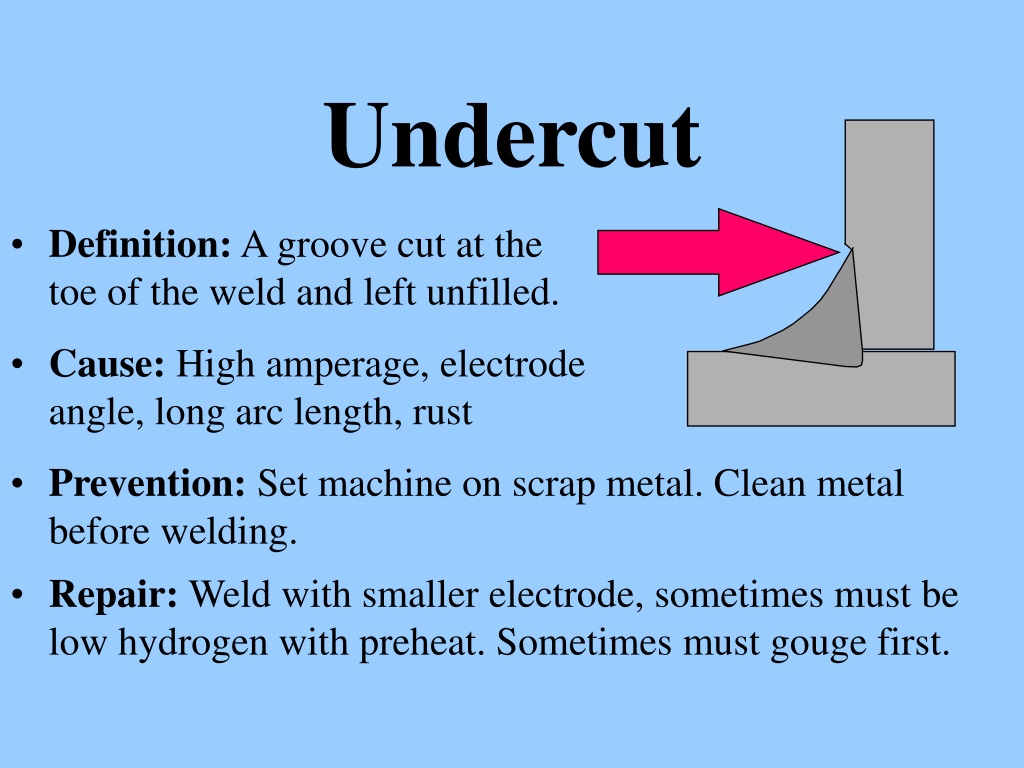Preventing Weld Undercut Made Easy: Trick Techniques Introduced
Preventing Weld Undercut Made Easy: Trick Techniques Introduced
Blog Article
Grasping the Art of Welding: Exactly How to Stay Clear Of Undercut Welding Issues for Flawless Manufacture Results
By recognizing the root causes of undercut welding and carrying out effective methods to avoid it, welders can raise their craft to brand-new degrees of excellence. In the quest of perfect manufacture outcomes, mastering the art of welding to prevent undercut concerns is not just a skill however a need for those making every effort for excellence in their job.
Recognizing Undercut Welding

To prevent undercut welding, welders should make sure proper welding specifications, such as readjusting the current, voltage, travel rate, and maintaining the appropriate electrode angle. By understanding the reasons of undercut welding and implementing preventative procedures, welders can accomplish top quality, structurally sound welds.
Reasons of Undercut in Welding
Comprehending the aspects that add to undercut in welding is necessary for welders to create high-quality, structurally sound welds. Undercutting occurs when the weld steel does not properly load the groove formed in between the base steel and the previously transferred weld metal. A number of factors can cause undercut in welding. One typical reason is excessive warmth input. Welding at heats for prolonged periods can lead to the base metal thawing even more than wanted, resulting in undercut. Poor welding current or incorrect welding speed can also contribute to undercut. Insufficient current might not supply sufficient warm to thaw the base and filler steels adequately, while extreme speed can protect against appropriate blend, causing undercut. In addition, inappropriate electrode angles or inaccurate lantern control methods can produce locations of low weld metal deposition, advertising undercut. Recognizing these reasons and executing proper welding techniques can help stop damaging concerns, guaranteeing sturdy and strong welds.
Strategies to stop Undercutting

To mitigate the danger of undercutting in welding, welders can use critical welding strategies intended at enhancing the top quality and integrity of the weld joints. Additionally, making use of the proper welding technique for the details joint configuration, such as weave or stringer beads, can add to minimizing damaging.
Additionally, proper joint prep work, consisting of guaranteeing clean base products totally free of contaminants More hints and utilizing the proper welding consumables, is important in preventing undercut defects. Employing back-step welding techniques and controlling the weld grain account can also aid distribute warmth evenly and reduce the risk of undercut. Routine assessment of the weld joint during and after welding, in addition to implementing quality control actions, can help in addressing and discovering damaging issues without delay. By implementing these methods faithfully, welders can attain perfect manufacture results with minimal undercut defects.
Value of Appropriate Welding Parameters
Picking and maintaining suitable welding specifications is essential for accomplishing effective welds with very little flaws. Welding parameters describe variables such as voltage, existing, take a trip speed, electrode angle, and shielding gas flow rate that straight affect the welding process. These criteria must be carefully adjusted based upon the sort of material being welded, its density, and the welding technique utilized.
Correct welding parameters make certain the correct amount of warmth is put on thaw the base metals and filler product consistently. If the parameters are established too expensive, it can bring about extreme warm input, causing burn-through, spatter, or distortion. On article source the other hand, if the specifications are also reduced, incomplete fusion, lack of penetration, or undercutting may happen.
Quality Control in Welding Procedures

Final Thought
Finally, understanding the art of welding calls for a complete understanding of undercut welding, its causes, and methods to stop it. By guaranteeing appropriate welding parameters and implementing top quality assurance methods, remarkable construction outcomes can be achieved. It is vital for welders to consistently strive for excellence in their welding operations to prevent undercut concerns and create high-quality welds.
Undercut welding, a common defect in welding processes, takes place when the weld steel doesn't effectively load the groove and leaves a groove or anxiety along the welded joint.To protect against undercut welding, welders ought to ensure appropriate welding specifications, such as changing the existing, voltage, traveling speed, and preserving the right electrode angle. Poor welding existing or incorrect welding speed can likewise add to damage.To alleviate the risk of undercutting in welding, welders can employ calculated welding methods aimed at improving the quality and integrity of the weld joints.In conclusion, mastering the art of welding you can look here requires a complete understanding of undercut welding, its causes, and strategies to stop it.
Report this page